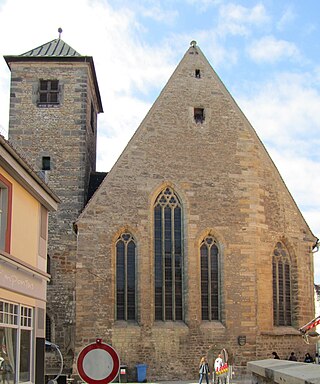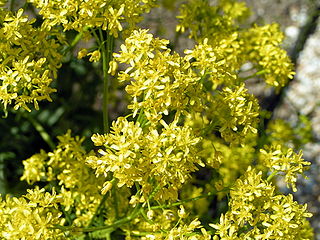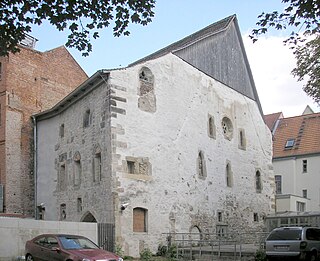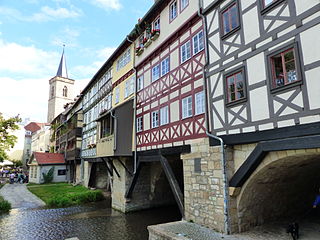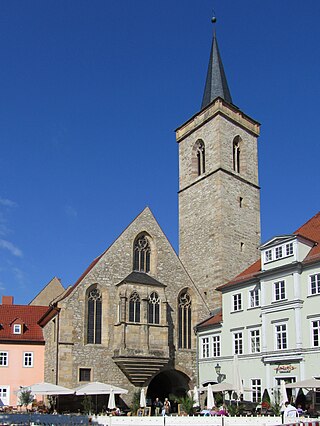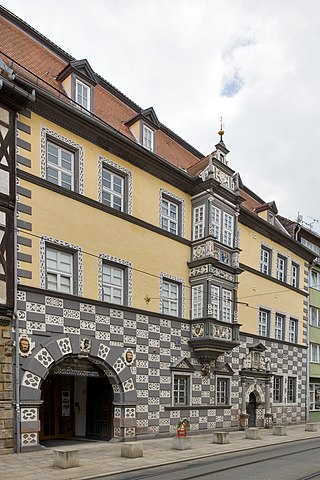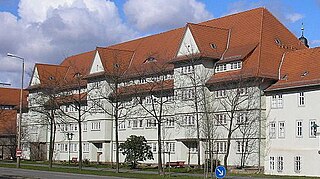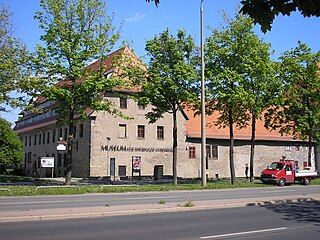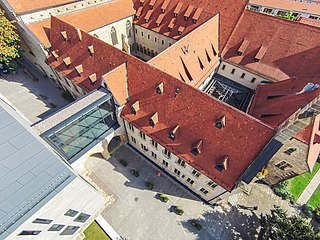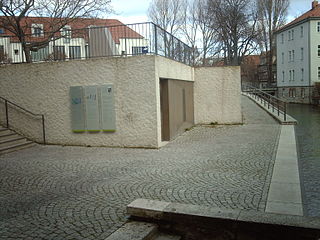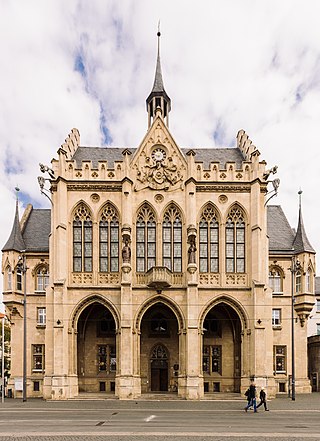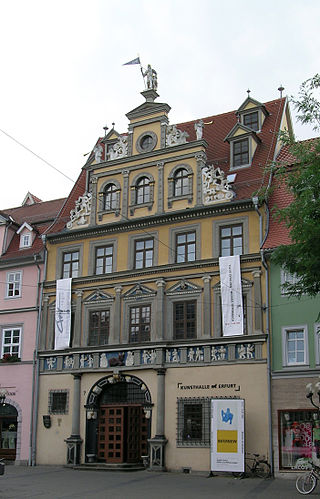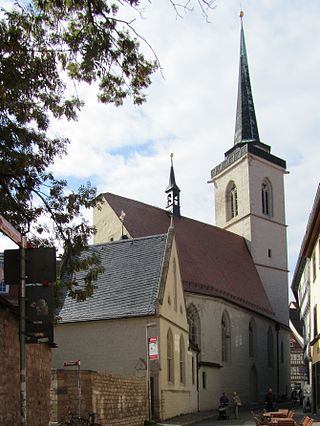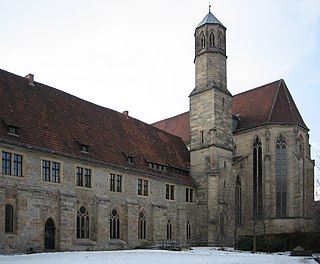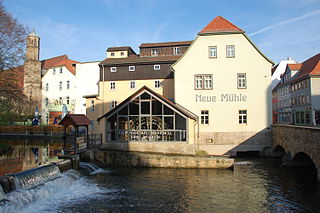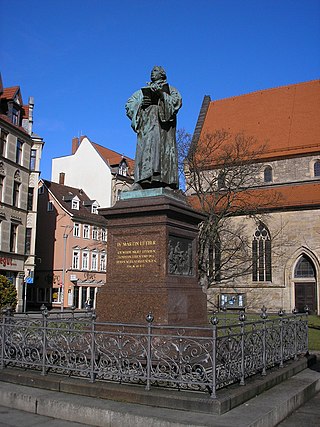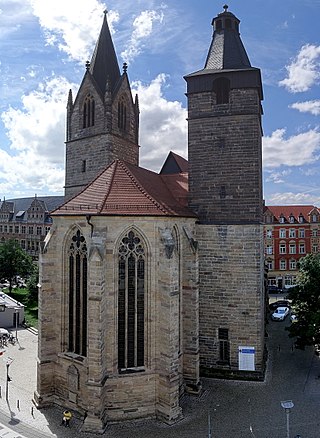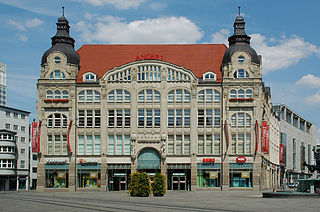Self-guided Sightseeing Tour #2 in Erfurt, Germany
Legend
Tour Facts
7.1 km
108 m
Experience Erfurt in Germany in a whole new way with our free self-guided sightseeing tour. This site not only offers you practical information and insider tips, but also a rich variety of activities and sights you shouldn't miss. Whether you love art and culture, want to explore historical sites or simply want to experience the vibrant atmosphere of a lively city - you'll find everything you need for your personal adventure here.
Individual Sights in ErfurtSight 1: Zitadelle Petersberg
Petersberg Citadel in Erfurt, central Germany, is one of the largest and best-preserved town fortresses in Europe. The citadel was built on Petersberg hill, in the north-western part of the old town centre from 1665, when Erfurt was governed by the Electorate of Mainz. It is surrounded by over two kilometres of stone walls and is 36 hectares in size.
Sight 2: Denkmal für den unbekannten Wehrmachtsdeserteur
The monument to the unknown Wehrmacht deserter and to the victims of Nazi military justice in front of the Philipp Bastion of the Petersberg Citadel was inaugurated on 1 September 1995.
Sight 3: Bonifatiuskapelle
St Severus' Church in the city of Erfurt in Thuringia, Germany, is a Roman Catholic church building. It stands on the Domberg directly next to St Mary's Cathedral. As a unique architectural ensemble, both churches together form the city's landmark. Due to its unusual form, which seems to anticipate the late Gothic hall church, St Severus' Church is one of the most important Gothic buildings in Germany. The bones of the church patron Severus of Ravenna rest in an artistically very significant sarcophagus.
Sight 4: Minerva
The Minerva Fountain is a fountain on the cathedral square in Erfurt, Germany.
Sight 5: Erthal-Obelisk
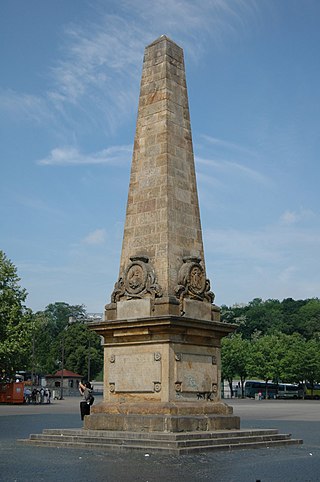
The Erthal Obelisk is an 18-metre-high obelisk on the cathedral square in Erfurt. It was erected around 1777 on the occasion of the first visit of the Archbishop of Mainz and Erfurt city lord Friedrich Karl Joseph von Erthal, making it one of the oldest monuments in Erfurt. The construction costs were 1120 thalers, of which the citizens raised 858 in a collection. The work of a master builder who has not survived is made of Wandersleben sandstone and has a square base made of granite with a laurel-wreathed effigy, name, coat of arms and initials, orders and decorations. In earlier times, a dedication in the stone explained that the "loyal subjects of the local city to the best father of the country" had built this monument "in eternal memory".
Sight 6: Sankt Andreas
St Andrew's Church is a Gothic church building at Andreasstraße in the historical centre of the city of Erfurt in Thuringia, Germany. The surrounding quarter Andreasviertel and the northern district Andreasvorstadt are named after it. St Andrew's Church is now a Lutheran parish church.
Sight 7: Collegium Maius
The Collegium Maius was the main building of the Old University in Erfurt, which existed from 1392 to 1816. A new building built in the old style from 1998 onwards is located in Michaelisstraße in the centre of Erfurt's old town, in the so-called "Latin Quarter", after the destruction of the old building in 1945. The old building housed the rectorate, lecture halls and the large ballroom of the university. In 2011, the regional church office of the Evangelical Church in Central Germany, which was created by merger in 2009, moved into the new Collegium Maius.
Sight 8: Michaeliskirche
St Michael's Church in the historical centre of the city of Erfurt in Thuringia, Germany, is a Gothic church building. It belongs to the Evangelische Stadtmission Erfurt and is the university church of the University of Erfurt.
Sight 9: Färberwaid
Isatis tinctoria, also called woad, dyer's-weed, or glastum, is a flowering plant in the family Brassicaceae with a documented history of use as a blue dye and medicinal plant.
Sight 10: Old Synagogue
The Old Synagogue is a former Jewish congregation and synagogue, located in Erfurt, Thuringia, Germany.
Wikipedia: Old Synagogue (Erfurt) (EN), Website, Heritage Website
Sight 11: Krämerbrücke
The Krämerbrücke is a medieval arch bridge in the city of Erfurt, in Thuringia, central Germany, which is lined with half-timbered shops and houses on both sides of a cobblestone street. It is one of the few remaining bridges in the world that have inhabited buildings. It has been continuously inhabited for over 500 years, longer than any other bridge in Europe. The stone, pedestrian bridge, which dates from 1325, is one of the oldest secular structures in Erfurt. It spans the Breitstrom, a branch of Gera River, and connects two town squares – Benediktsplatz and Wenigemarkt.
Sight 12: Ägidienkirche
St Giles' Church in the historical centre of the city of Erfurt in Thuringia, Germany, forms the eastern entrance from Wenigemarkt to the Krämerbrücke with its archway. The single-nave Gothic church building is one of the former two bridgehead churches. At the western end stood the Benediktikirche since the 11th century, which was demolished in 1890 and is now only remembered by the name of Benediktsplatz.
Sight 13: Kaisersaal
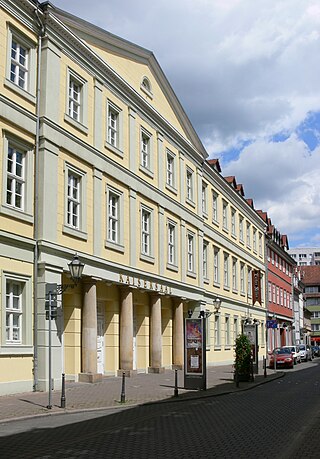
The Kaisersaal is a traditional cultural and congress centre in the old town of Erfurt. The Erfurt Princes' Congress of Emperors Napoleon I and Tsar Alexander I took place here in 1808 and the Erfurt party congress of the SPD in 1891. On April 12, 1946, Communists and Social Democrats passed the "Resolution on the Unification of the KPD and SPD to form the Socialist Unity Party of Germany SED" at a joint meeting at the local level in the Kaisersaal. The Kaisersaal is located in a listed ensemble at Futterstraße 15/16.
Sight 14: Schottenkirche
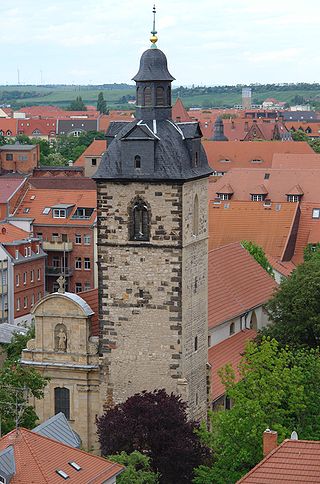
The Schottenkirche in the historical part of the city of Erfurt in Thuringia, Germany, is a Roman Catholic church building dating back to the 12th century. The Romanesque basilica belonged to a former Celtic monastery of St James. Today, it is a subsidiary church of the Catholic parish of St Lawrence's Church.
Sight 15: Schotte
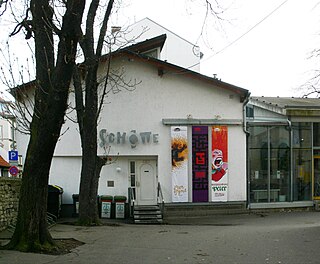
The Theater Die Schotte is a cultural institution in Erfurt.
Sight 16: Stadtmuseum
The Haus zum Stockfisch is an important Renaissance town house at Johannesstraße 169 in the old town of Erfurt. It was acquired by the city at the beginning of the 20th century and has been used as a museum ever since, and since 1974 it has been the seat of the city museum.
Sight 17: Großes Hospital
The Great Hospital was the hospital of the medieval city of Erfurt. It is located in the eastern extension of the old town between the inner and outer Krämpfertor on today's Juri-Gagarin-Ring.
Sight 18: Museum für Thüringer Volkskunde
The Museum of Thuringian Folklore Erfurt is one of the largest folklore museums in Germany. It is housed in buildings of the former Great Hospital on Juri-Gagarin-Ring in Erfurt.
Wikipedia: Museum für Thüringer Volkskunde Erfurt (DE), Website
Sight 19: Augustinerkirche
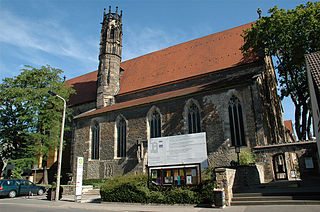
The Augustinian monastery in Erfurt is a former monastery of the Augustinian hermits, built from 1277 onwards, where Martin Luther lived as a monk between 1505 and 1511. After the Reformation, the monastery became the property of the Protestant Church in 1525; In 1559 it was secularized by the city of Erfurt. In 1945, parts of the monastery were destroyed in an air raid, but soon rebuilt to such an extent that the complex could be put to a new use, it became an official Luther memorial and parts served as a preacher's school. After the fall of the Berlin Wall, around 1994, the Augustinian monastery became the official seat of the Erfurt-Nordhausen Provost's Office. The building is mainly used as a conference and meeting centre. The monastery was extensively restored and modernized from 2000 onwards. It is a recognized cultural monument according to the Thuringian Monument Protection Act.
Sight 20: Evangelisches Augustinerkloster zu Erfurt
St. Augustine's Monastery in Erfurt, central Germany, is a former church and friary complex dating from the 13th century. The site is almost one hectare in size. It was built by Augustinian friars, an order of the Catholic Church. It is most well known as the former home of Martin Luther (1483–1546), the father of the Reformation, who lived there as a friar from 1505 until 1511.
Sight 21: Mikwe
The Erfurt Mikveh is a Jewish ritual bath of medieval origin in the old town of Erfurt an der Gera in the area of the Krämerbrücke. It belongs to the Erfurt Network for Jewish Life.
Sight 22: Kleine Synagoge
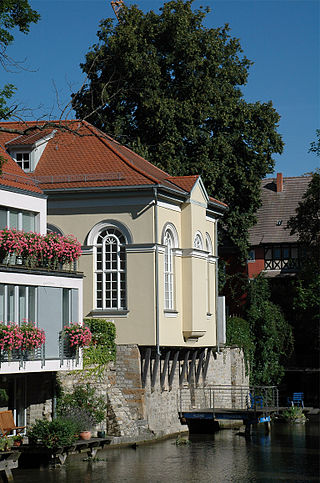
The Small Synagogue is a former synagogue in Erfurt, Thuringia, Germany. It is located in the old town directly on the Gera behind the town hall and has been used as a cultural centre since 1993.
Sight 23: Rathaus Erfurt
The Erfurt town hall is located at the fish market in Erfurt. The main building was built in the 1870s in a neo-Gothic style.
Sight 24: Römer
The Roman is a statue in the form of a Roman warrior on the fish market in Erfurt, directly opposite the Erfurt town hall. The statue is of a Roman warrior armed from head to toe with the insignia of the Roman Republic, holding the city flag of Erfurt in his right hand.
Sight 25: Kunsthalle Erfurt
The Kunsthalle Erfurt is located in Erfurt's old town, at the fish market in the Haus zum Roten Ochsen. This is also the headquarters of the Erfurter Kunstverein.
Sight 26: Allerheiligenkirche
All Saints' Church in the city of Erfurt in Thuringia, Germany, is a small Roman Catholic church building dating from the 12th to 14th century. The Gothic hall church is located at the fork of Allerheiligenstraße and Marktstraße in the historical centre of Erfurt. It has an irregular floor plan and, at 53 metres, the highest church tower in the old part of the city. Since 2007, it has been the first Roman Catholic church in central Germany to house a columbarium.
Sight 27: DenkNadel
A memorial pin is used in Erfurt to commemorate Jews from Erfurt who were deported and murdered during the Nazi era, similar to Gunter Demnig's stumbling stones. The Denknadel project was developed by the Erfurt Commemoration 1933–1945 working group and, after a competition in 2007, decided in favour of Sophie Hollmann's design. Since then, nine Denknadel have been installed in the Erfurt city area.
Sight 28: Theater Waidspeicher
The Waidspeicher Theatre is a professional puppet theatre in Erfurt.
Wikipedia: Theater Waidspeicher (Puppentheater) (DE), Website
Sight 29: Kabarett Die Arche
The Thuringian satirical theatre and cabaret Die Arche e.V. was founded in Erfurt in 1979. The venue is the Erfurt Theater Waidspeicher, a former warehouse for dyer's woad.
Sight 30: Maria-Magdalenen-Kapelle
The Magdalenen Chapel is a small profaned church building in Erfurt's old town. It belongs to the cathedral community and was originally a cemetery chapel. Today it is used as a columbarium.
Sight 31: Predigerkirche
The Predigerkirche is a Lutheran church in Erfurt, central Germany. It is a monastic church to the Dominican friary, Predigerkloster, adjacent to the church. The name of the Preachers' Church derives from the designation of the Dominicans as "Preacher Brothers". The Predigerkirche was originally built by the Dominican Order in the 13th century, when the mystic Meister Eckhart was prior here. The original building was modified in 1340–50, and the bell tower was built between 1447 and 1488. The church became Protestant after the Reformation. Around 1806, the Predigerkirche was used as a prisoner-of-war camp, which led to damage to the interior and the equipment. Repairs were made around 1826.
Sight 32: Neue Mühle
The Neue Mühle is a technical museum on the Schlösserbrücke in Erfurt, Thuringia. It is located on a tributary of the small river Gera, which operates the mill's hydroelectric power plant. It contains a grain mill with an undershot Zuppinger water wheel and is the last functioning mill of 60 in the city. It has borne its name as the "New Mill" since its reconstruction after the fire of 1735. Particularly interesting is the preserved material flow over all floors by means of a belt bucket elevator. In addition to a milling process, historic roller mills, several plansifters and a mill brake elevator can be seen.
Sight 33: Sankt Lorenz
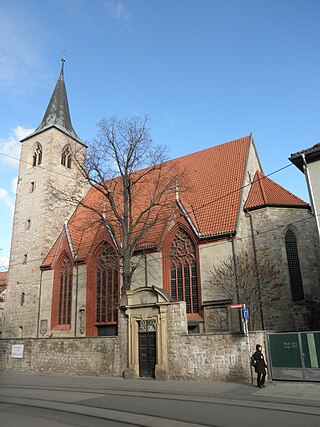
St Lawrence's Church in the city of Erfurt in Thuringia, Germany, is a Roman Catholic parish church dating from around 1300. The Gothic hall church is located on the northern edge of Anger square and at the beginning of the Schlösserstraße in the centre of the historical part of Erfurt.
Sight 34: Lutherdenkmal
The Luther Monument is a monument in honour of the reformer Martin Luther in front of the Kaufmannskirche St. Gregor on the Anger in the centre of the city of Erfurt in Thuringia.
Sight 35: Kaufmannskirche - Sankt Gregorii
The Kaufmannskirche is a church building in the historical centre of the city of Erfurt in Thuringia, Germany. It is located at the north end of Erfurt's Anger square and has been Lutheran since 1521.
Sight 36: Anger 1
The Anger 1 shopping gallery is a shopping centre at the north-eastern end of the Anger in the centre of Erfurt and consists of an old Art Nouveau building and a modern new building with a multi-storey car park.
Share
How likely are you to recommend us?
Disclaimer Please be aware of your surroundings and do not enter private property. We are not liable for any damages that occur during the tours.
GPX-Download For navigation apps and GPS devices you can download the tour as a GPX file.
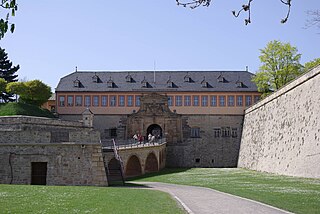
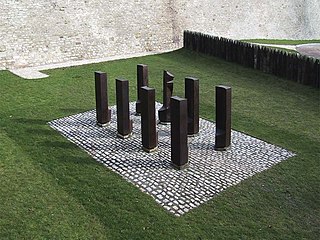
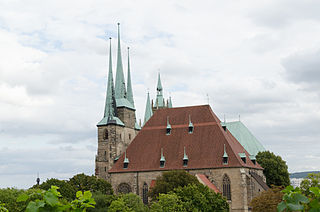
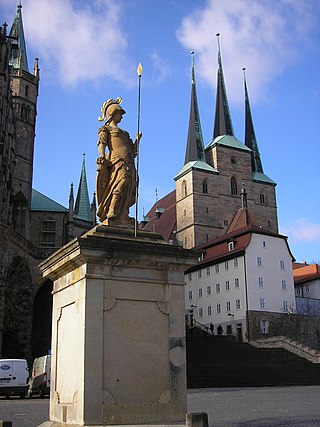
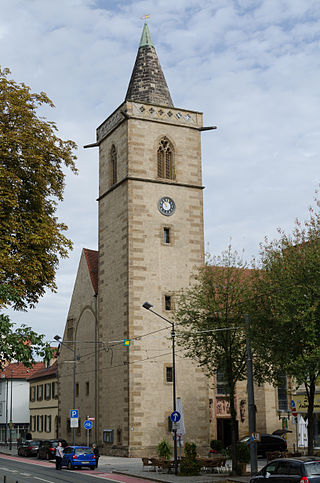
.jpg)
